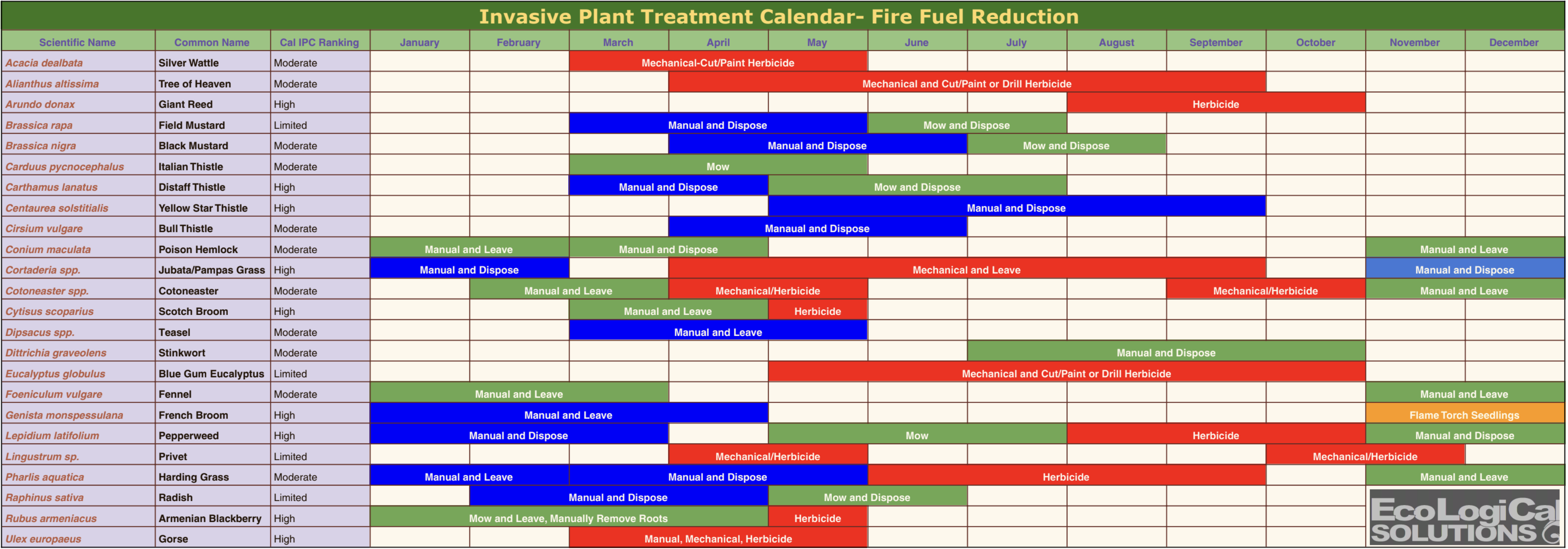DO THE WORK
Invasive Species Management
Invasive species are non-native, aggressively spreading plants that cause environmental, economic, or human harm. Sometimes they’re called weeds. Invasive plants are pervasive and persistent. Active stewardship, including regular surveys to detect the arrival of new invasives, can limit the harm they cause.


French broom (Genista monspessulana), one of Sonoma County’s most common weeds. Photo: Cal-IPC.org.
Benefits
Without active stewardship, invasive species can spread aggressively, displacing native plants that provide food and habitat to wildlife, and degrading cultural and economic resources. Invasive species often use more water and resources than native plants, ignite more easily, and contribute to more severe, destructive wildfires.
Removing invasive plants also creates safer access along the roads for firefighters and residents, and fosters diverse, more resilient habitats by reducing competition for native species.
When & Where to Manage Invasive Species
Invasive species are usually a higher priority where fire has occurred; where soil has been disturbed by digging, scraping, grading, landslides, or vehicle traffic; or where rare or sensitive plants might be over-run by invasives.

Using a propane torch to kill young French broom in a post-fire mixed hardwood forest near Glen Ellen. Photo: Sonoma Ecology Center
Key Points Before Proceeding
Invasive species often establish from seeds that germinate in disturbed soil–along a road cut, after heavy equipment work, or after a landslide–or seeds that are accidentally spread along frequently traveled roads.
 There are four general strategies for invasive species management, depending on the extent of the problem, as shown in the invasion curve infographic above. They are listed from lesser to greater investment.
There are four general strategies for invasive species management, depending on the extent of the problem, as shown in the invasion curve infographic above. They are listed from lesser to greater investment.
- Prevention
- When leaving an area where there might be invasive plants, it is important not to transport any seeds, fruit, or root pieces. Wash or brush your boots before leaving a potentially contaminated area. Request decontamination from any crews coming to work on the property; include this language in any contract. (Cal-IPC.org provides a check-list of gear, tools, and equipment to clean.)
- Retain healthy native vegetation to fend off invasive species. This strategy has the most benefits and fewest downsides. Healthier, more biodiverse landscapes can present biotic resistance, meaning they are more resistant to invasive species.
- Some nurseries sell invasive plants, often in their “exotic” or “decorative” sections. Check out this page for ideas on which invasive species to avoid and what to plant instead.
- Early eradication
- Early detection, rapid response – stopping invasions early is always easier than removing a population that has spread widely.
[Web designer: 1. This graphic should be placed next to or very near the sentence above that starts with “there are four general strategies…”. 2. please caption the “Invasion Curve” graphic as: Infographic from National Park Service, adapted from Invasive Plants and Animals Policy Framework, State of Victoria, Australia.]
- Prioritize species and populations based on most important locations to protect and available resources
- Start with satellite populations around the edges of infestations; progress towards older, denser populations and/or the source of the infestation
- Create stability in heavily degraded areas and reestablish a trajectory of proper ecological functioning
- Often a mix of the above strategies are used simultaneously across different sites on a property.
Tips on strategy
The key first step is to accurately identify which species are present and the distribution of both natives and invasives. Working with a professional can help identify problematic species and create a management plan.
The next step is learning the life cycle of target species to determine the optimal window for treatment.
Then you can start to prioritize control efforts for invasive treatments based on resources and capacity.
Determine whether the plant is an annual or perennial.
- Annual plants often pose significant ignition threats, and generally surge in the spring before setting seed in the summer.
- Perennial plants return each year and can dramatically increase ladder fuels, which in turn increases the risk that fire will climb into the tree canopy and lead to catastrophic crown fires.
Dense or mature infestations often require repeated yearly treatments. In some cases, native species will reestablish naturally; other sites may need active restoration, such as planting. In contrast, new invasions that are detected early are more easily controlled. Once these trajectories are accounted for and natives have the chance to reestablish, wildlands can be more resilient to future infestations and to fire.
Jason M. Mills, Senior Restoration Contractor, Ecological Solutions
How to Manage Invasive Species
The most effective way to identify new invasive plants is to walk your property seasonally, paying attention to common species and how they look at different times of year and different points in their life cycle.
To start managing any invasive species:
- Identify the boundaries of invasive species populations and mark them with control lines in the field and/or on a map. This way you can track your progress and see how the infested area expands or contracts.
- Identify sensitive or critical habitat areas that you want to keep invasive species away from.
- Remove plants that cross the line first, and then work inward towards the original source. That is, start in areas with the least number of individuals rather than starting with the densest area. This clears the largest possible area of invasives before engaging with more heavily compromised areas.
Top Invasive Species of Sonoma County
One of the most detrimental weeds in Sonoma County’s forests are brooms: Spanish broom (Spartium junceum), Scotch broom (Cytisus scoparius), and especially French broom (Genista monspessulana)
Treatment Options, Mapping, and Tracking
Consider the options available for treatment. Research can show what is most effective against particular species and help describe potential impacts to the site and personnel performing the work. Tools in the tool box include:
- Manual: hand tools
- Mechanical: power tools and small to large equipment
- Cultural: beneficial fire, grazing, biological controls
- Chemical: herbicides
Create a plan to see these efforts through until desired goals are reached. Mapping and monitoring become critical tools to track success over time. Assess vegetation before starting work to establish a baseline and take before and after photos from set locations.
Mapping programs such as georeferenced Avenza maps allow for positioning and tracking in the field. GIS mapping programs also allow for analysis of collected data. CalFlora provides data fields and interactive features to share information and show where work has occurred or needs to be prioritized.
Jason M. Mills, Senior Restoration Contractor, Ecological Solutions


Before and after hand removal of French Broom along Dinnucci Road near Glen Ellen. Photos: Eric Schoohs, Sonoma Ecology Center.
How to Manage Invasive Species
- The seed bank often flushes or germinates after fire, creating huge infestations, but it’s important to know that the infestation was not brought by the fire. Seeds remain viable for decades, so repeat treatment and consistent monitoring are critical. Treatments and monitoring are only needed every other year, because it takes that long for new plants to create viable seed.
- Successive flushes of the seed bank over two to three years usually greatly diminish the number of seedlings that germinate each year, reducing the work needed to control broom in that area.
- Manual removal is most effective in spring or early summer before flowers turn to seeds; large plants require tools that remove roots.
- Generally, cutting or mowing mature broom does not kill it, and increases the difficulty of manually removing the roots. However, mowing young broom plants (those that have not been cut before and are under 12 inches in height) at ground level in the spring, with follow-up in the fall of the same year, can often kill them.
Other widespread invasive plants are listed here. Click each link to see plant information, management guides, and articles and research.
- Ivy: English (Hedera helix), Algerian (Hedera canariensis), and Cape (Delairea odorata)
- Himalayan (or Armenian) Blackberry (Rubus armeniacus)
- Silver Wattle (Acacia dealbata, Acacia sp.)
- Tree of Heaven (Ailanthus altissima)
- Poison Hemlock (Conium maculatum)
- Giant Reed (Arundo donax)
- Pampas (or Jubata) Grass (Cortaderia selloana, C. jubata)
- Stinkwort (Dittrichia graveolens)
- Thistles: Yellow Star (Centaurea solstitialis), Italian (Carduus pycnocephalus), Milk (Silybum marianum) and Bull (Cirsium vulgare)
- Grasses: Medusa Head, Barbed Goat, Harding,
- Periwinkle (Vinca major)
- European beachgrass (Ammophila arenaria)
- Ice plant (Carpobrotus edulis)
Variations on this Practice
The appropriate mix of methods depends on how dominant the invasive species are compared to desirable native plant species. When timed correctly, Beneficial Fire can be a useful tool to manage many invasive species.
WEED Control User Tool (WEEDCUT), a tool from UCANR, can provide guidance on a range of methods for managing invasive plants in wildlands to help you choose which actions are most effective in different situations.
Timing for Managing Invasive Species
[Click image to view full size graphic]
By Jason M. Mills, Senior Restoration Contractor, Ecological Solutions
If plants are large enough that managing them will cause a disturbance, it’s best not to do the work during bird nesting season, March through August. If substantial disturbance must be done during nesting season, consider Nesting Bird Surveys.
Equipment
Personal Protective Equipment (PPE)
- Long pants
- Long sleeve shirt
- Boots
- Helmet
- Leather gloves
- Eye and ear protection
Tools
- Hand saw
- Pruner
- Loppers
- Digging tools, such as pick-mattocks, pulaskis, or shovels, weed wrenches, hard rakes or Mcleods
- Tarps for transportation of materials
Maintenance
Observing the land regularly by walking along common routes of transmission (roads and trails, neighboring land uses), as well as around known populations of invasives can help reduce further spread or new invasions.
“Maintenance is about preventing further outbreaks from occurring and establishing. Monitoring historic problem spots along roads and other access points, limiting movement of equipment and vehicles through infested areas during wet season and seed season, and being knowledgeable about where materials such as gravel or rock are coming from are all important steps to maintaining your hard work.” -Tori Norville, UCCE.
Related Practices
Retaining & Creating Habitat Features
Managing Roads & Trails (coming soon)
Please note: this is a general guide. The specifics of how and when to do this practice will depend on many factors, including the site’s particular vegetation, climate and topography, history, and land management goals. Always consult with a professional if you’re unsure.
Do you have your principles in mind? Remember to regularly check in with your land management goals, to assure your practices and actions will actually achieve them.
Additional Resources
An article on invasive species in Sonoma from Sonoma County Regional Parks
Two articles from the California Native Plant Society on preventing the spread of Invasive Plants
California Invasive Plant Council, an excellent website for invasive species identification and stewardship. Cal-IPC also publishes a series of helpful guidebooks on best practices, including non-chemical weed management and a decontamination check-list for contractors
California Native Plant Society, a nonprofit that provides advice on land management practices to preserve native plants
UC’s Integrated Pest Management Program provides excellent information on invasive species identification and best practices in stewardship
The cost of Invasive species in California
Find out what native plants grow in your area with Calflora
UCCE Forest Stewardship Series 14: Exotic Pest Plants: more information on Integrated Pest Management methods, prevention, and general information
UC IPM Pest Notes, Publication 74147: Brooms: broom-specific information including identification and information about control methods
UC Davis/UCANR Weed Research & Information Center: database of control information for common invasive species
UCANR WEED Control User Tool (WEEDCUT), database of methods for managing invasive plants which can be sorted by various categories including: plants, methods of control, and tools



